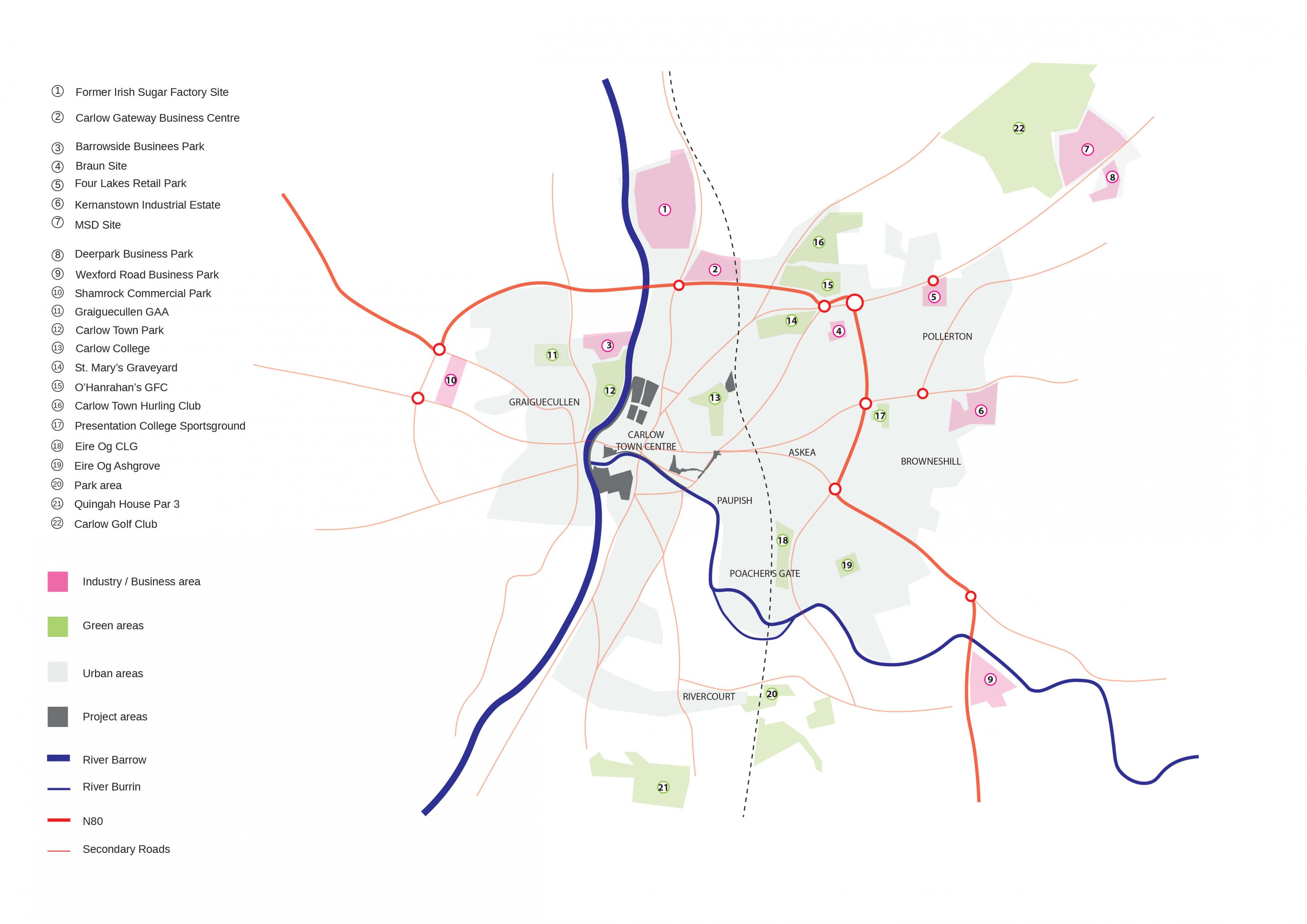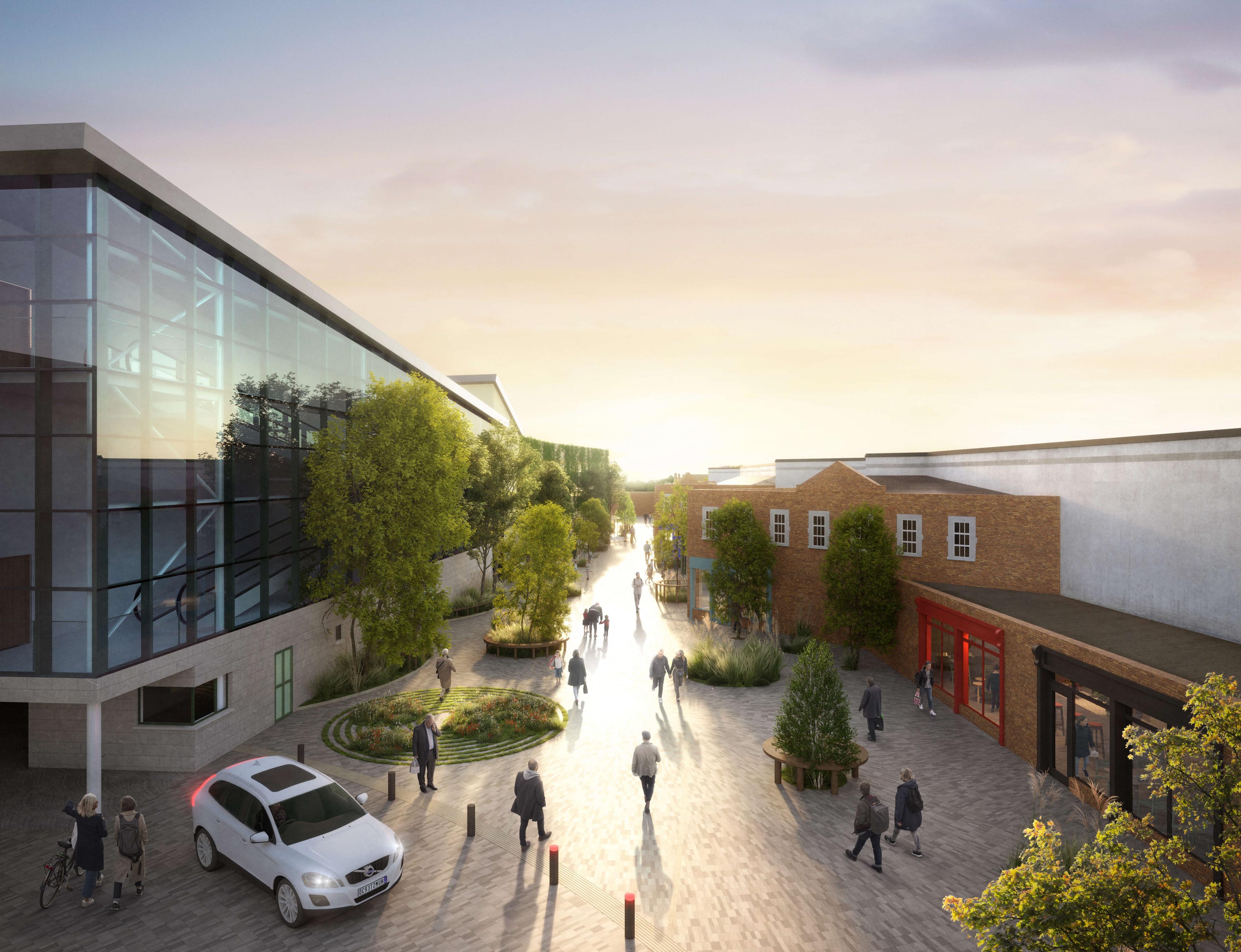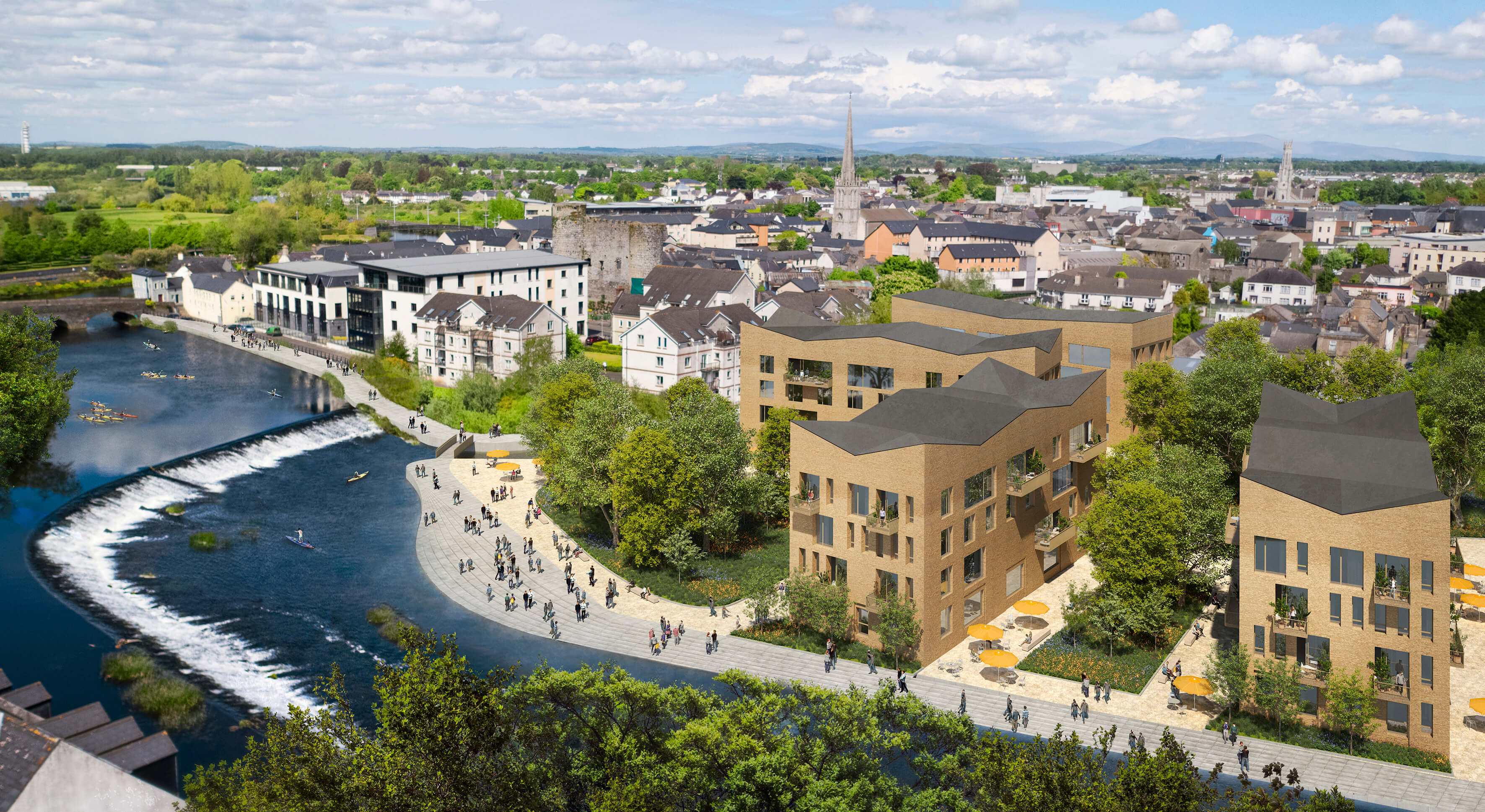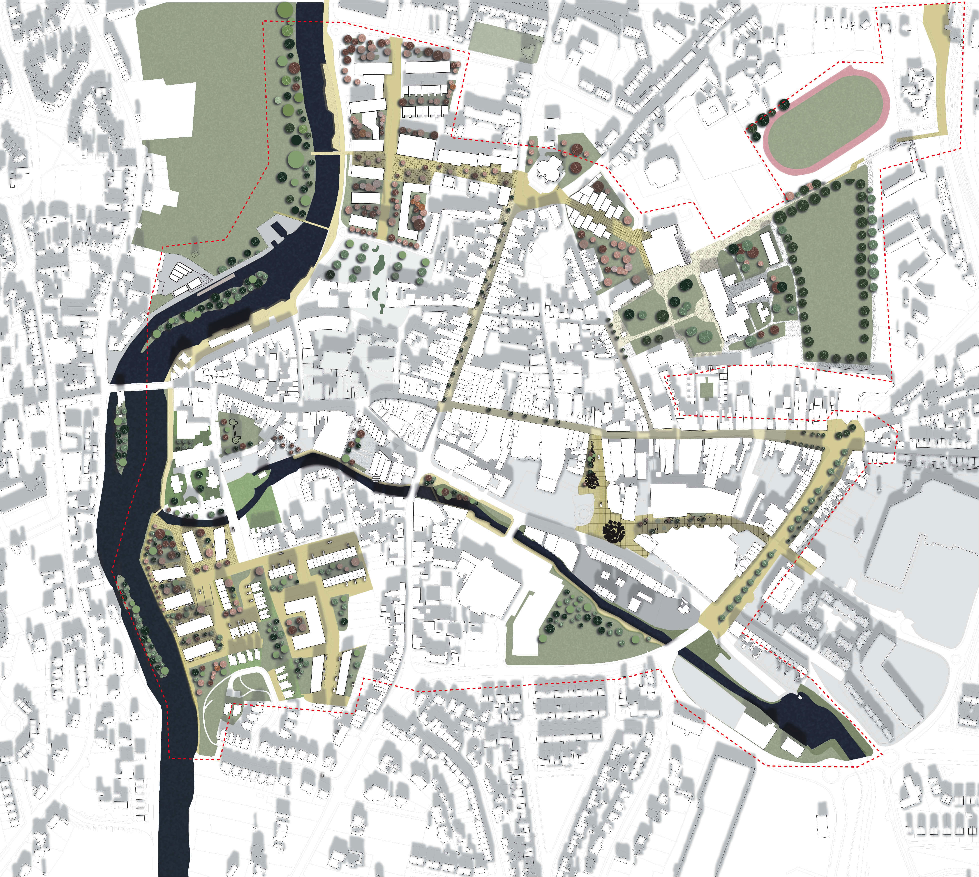Introduction
The Project Carlow 2040 Regeneration Strategy sets the long-term strategy and approach to the spatial pattern of development in Carlow Town over the next 20 years. As a long term plan it informs and will drive the economic, social and physical development of Carlow Town as an investment location and place to live, setting the direction for the development of strategic sites.
The Regeneration Study Area
Carlow Town is the principal centre of economic activity in County Carlow and an important County Town in the Southern Region. The core of the Town is located to the east of the River Barrow and while this area is the focus for Town Centre uses and economic activity it currently lacks a sense that it is the ‘Heart of the Town’.
As shown opposite, this Strategy addresses the existing Town Centre area, from the Potato Market through to Barrack Street, Carlow College and the Railway Station as well as link streets such as Tullow Street, Dublin Street and Shamrock Square.
The Strategy area also encapsulates a section of the River Barrow to the west, including the Barrow Track, Carlow Castle and the Burren River and the Pembroke area to the southwest of the Town Centre.
This Study Area for the Project Carlow 2040 Regeneration Strategy is shown in the context fo the wider Carlow area in the Context Map overleaf.
Context Map

Context
The Development of Carlow Town
The Carlow Town area has a rich and varied history dating back many millennia, the Browneshill Dolmen to the east of the Town being a prominent megalithic tomb dating to c.3,500 B.C.
Following the Anglo-Norman invasion of Ireland, Carlow Castle was built in the early 13th Century by William Marshal, Earl of Pembroke and Lord of Leinster. The Castle was constructed to defend a crossing point of the River Barrow and is likely the basis for the development of Carlow Town in its current location.
Carlow once served as the administrative capital of the Lordship of Ireland under King Edward III from 1361 – 1374. Carlow Castle itself had survived largely intact from the 13th Century until 1814 when unsympathetic efforts were made to redevelop it. Parts of the bridge over the River Barrow are also of historical significance, dating back to the 16th Century. The current layout of the Town dates back to this time when it functioned as a market town serving a substantial rural hinterland. It continued to fulfill this role for over two centuries.
The 18th Century saw the commencement of Carlow’s connection with third-level education, with Carlow College, St Patrick’s founded in 1782. The College, a liberaL arts college, was established following relaxation of the penal laws and is Ireland’s second oldest university-level institution. The 18th Century was, however, also a dark time in Carlow Town’s history with 600 United Irishmen killed in the Town in an attempt to free their fellow countrymen as part of the 1798 Rebellion. Those killed are buried in the Croppie Graves in Graiguecullen and the battle in the Potato Market area is commemorated with the Liberty Tree Monument by renowned artist John Behan.
The 19th Century in Carlow brought advancements in architecture and infrastructure with the development of Carlow Courthouse, Duckett’s Grove and Carlow Cathedral, one of the first Catholic Cathedrals in Ireland. These stand today as testament to the architectural heritage and development of the Town. This Century also witnessed the arrival of the rail line which connected the Town to Dublin and the south-east, offering not only enhanced accessibility but improved connectivity for social and economic activity.
The 20th Century heralded in a new era of economic development for Carlow Town, with Ireland’s first sugar beet factory built in the Town in 1926. The factory served the wider area and the Country for almost 80 years until its closure in 2005.
Since the 1960s Carlow had also become a location for international investment with companies like Braun and Lappel locating in the area. However, by the early 21st Century these manufacturing lead industries had closed, with the growing pharma industry now one of the largest employers in the Town following the opening of the MSD factory in 2008.
Carlow continues to function as a centre of education and the arts. The Town has two third level institutes, IT Carlow and Carlow College, as well as contemporary gallery and performance spaces at the VISUAL and George Bernard Shaw Theatre which opened in 2009 and the newly refurbished space close by for the Carlow County Museum.
Carlow Town as it stands today, has many assets as a place to live, as a regional centre and as a tourist destination including:
- Critical Mass: Carlow Town has a population of 24,272 which accounts for approximately half of the total population of the County.
- Arts and Culture: Carlow is a centre for the arts and cultural heritage, it accommodates significant modern arts and performance spaces as well as hosting renowned events such as the Carlow Arts Festival.
- Quality of Life: Carlow offers excellent quality of life, affordable living costs and distinct architectural and cultural heritage.
- Education Facilities: Carlow has a long history in the provision of third-level education, with two Institutes of Higher Education, IT Carlow and Carlow College, located within the Town.
However, like many other Regional and County Towns throughout Ireland, Carlow faces challenges with regard to Town Centre vitality, retail competitiveness, employment opportunities within the Town, infrastructure (road, rail and communications), public transport provision and Town Centre living.
The purpose of this Regeneration Strategy is to guide the long-term development of Carlow Town by re-purposing
the Town Centre and re-establishing a definable Core. The Vision for the Town seeks to build on its unique attributes and attractions in combination with addressing its existing challenges to make the Town a place for its people, where residents, workers and visitors alike will be encouraged, to access everything the Town Centre has to offer.
This will be achieved through a number of interventions including:
- Improved Town Centre linkages and increase pedestrian mobility;
- Permeability through Carlow College as a public space;
- Connecting the River Barrow and the River Burrin back to the Town, helping to provide the Town Centre with a unique character and identity while utilizing the opportunity for amenity and recreation along the riverfront while providing sustainable public realm spaces and routes;
- The delivery of a ‘Civic Spine’ development across Local Authority owned lands and into Carlow College;
- The creation of a residential quarter within Carlow Town in the Pembroke area; and
- The provision of a linear area, encompassing Carlow Castle, with a mix of cultural, historical, recreational, leisure and retail uses.
A Fresh Vision
Carlow Town is a service provider for the County and wider region, with the Town Centre acting as a driver for growth for the whole County. It is, therefore, important that the principal streets and spaces that form the heart of Carlow Town are functional, attractive and inviting. Furthermore, Carlow Town has a number of key opportunity sites in need of regeneration which afford the opportunity to deliver enhanced sustainable connectivity within the Town Centre, improve the health and wellbeing of residents and visitors, and promote sustainable activities and compact urban growth.
The Vision is for Carlow Town to be a high-functioning, inclusive, compact and accessible town underpinned by a robust and diverse local economy. The overriding objective is to deliver healthier streets which in turn will bring a number of social outcomes including inter alia safer, pedestrian friendly streets; a less car dependant Town Centre; better air quality; active travel; easier access; increased Town Centre living; improved inclusive public realm with a unique urban identity; and improved general wellbeing. The aim is to create a vibrant Town Centre providing for a network of linked open spaces, recreational uses and other social infrastructure elements that provides a good quality of life for all.
This Strategy, through proposed interventions at key opportunity sites, will act as a catalyst for the regeneration of the Town. Improving the connections between principal retail, educational and civic spaces in Carlow Town will entice people to spend more time in a vibrant and modern Town Centre, while providing more sustainable forms of movement around the Town will result in people choosing to leave their cars at home. Additionally, this Strategy seeks to re-establish a residential population within the Town Centre through the promotion of and provision for Town Centre living, as well as improved public realm spaces and better access and promotion of civic uses.
This Strategy for Carlow Town focuses development on the Town Centre and identifies opportunities in the built environment and the public realm which can be developed to the benefit of the community and the local economy. It will directly bring forward the regeneration of key opportunity sites in Carlow Town as identified in the Joint Spatial Plan for the Greater Carlow Graigeucullen Urban Area 2012-2018, as extended.
Under the Joint Spatial Plan, areas can be renewed by improving the appearance of the public realm, creating new linkages through existing open spaces and by reducing block sizes with innovative infill development and advancing specific sites for development. As per policies CTP 30, CTP 31, CTP 32, and CTP 33 it is encouraged to facilitate the redevelopment of Barrow Track Site (Opportunity Site 2); Court Place Site (Opportunity Site 3); Potato Market (Opportunity Site 4); Pembroke Road Sites (Opportunity Sites 6); Barrack Street (Opportunity Site 8); and In and around Train Station (Opportunity Site 9). The Interventions contained in this Strategy are the next step in realising the delivery of these sites.

This Strategy also builds on the work Carlow County Council has undertaken to date in relation to the revitalisation of the Town. The Council’s commitment to the regeneration of the Town Centre is highlighted by:
- Investment in the Carlow Regeneration Vision and Implementation Strategy 2040 (Project Carlow 2040);
- The acquisition of the former Bank of Ireland Building which is in close proximity to the Council’s buildings;
- The purchase of the Former Cash & Carry Site known as Perry’s;
- The complusory acquisition of residential properties on Barrack Street;
- The development and appointment of a Special Projects Development & Delivery Team to ensure that projects to allow for project delivery;
- The appointment of a Town Centre Co-ordinator as part of the Economic Team to engage with over 200 retailers in Carlow Town Centre;
- The development of a Town Development Forum Chaired by the Chief Executive with representatives from Industry and key stakeholders;
- The development of a core project plan supported by URDF to move a series of strategic projects from concept to development stage;
- Engagement with private sector landlords to work in partnership and develop sites in Carlow Town Centre;
- To support the development and operation of the South East Regional Economic Development Office which recognizes the development of Carlow Town in particular the opportunity for Technological University of the South East represents for Carlow;
- Strategic Business Case Development for Enterprise Hubs & Spaces in partnership with Enterprise Ireland & IDA; and
- Engagement with Failte Ireland in respect of visitor experience development in Carlow Town.
" Furthermore, Carlow College and the IT Carlow recently received funding for their collaborative consolidation project, which aims to enhance the provision of a first class educational experience for students in Carlow, strengthening the inter-institutional relationship between them. Significant investment has been made in higher education in Carlow and this Strategy will further support and enhance the strategic partnership between Carlow College and IT Carlow. In this regard the Strategy seeks to not only attract new students to the Town while enticing existing students to stay, but it will also significantly enhance connections between public transport, the Town Centre and educational facilities.
This Strategy will also support Carlow County Council in its position as a Champion under the UN’s Sustainable Development Goals Champions Programme. Carlow is the only Local Authority to be selected as a Champion alongside other organisations such as An Post, Musgraves and the GAA. The inclusion of sustainable growth principles and policies within this Strategy for the regeneration of Carlow Town Centre will provide an exemplar for future development in the Region and across the Country.
In line with national and regional policy, this Strategy is also innovative and offers a transformational sustainable approach to urban regeneration which has been tailored for Carlow Town. The implementation of the Interventions in this Strategy will not only regenerate large areas of the Town Centre but will improve health and wellbeing, create better town centre spaces, enhance competitiveness and commercial activity, promote town centre living and encourage building enhancements in order to improve the long term viability of Carlow Town.

Barrack Street and Potato Market Link
The Strategy provides a framework for the delivery of regeneration projects within the Town that can be brought forward through public and private partnerships and which will deliver tangible results in the form of employment opportunities, retail services, and residential units, as well as community and health benefits. The vision for the Strategy places the Health & Wellbeing of Carlow Town at its core, which has been the Principle Objective of Carlow County Council since the preparation and development of this Strategy began in 2019.
With the recent emergence of COVID-19, which has resulted in a global pandemic, Health & Wellbeing in urban environments is now, more than ever, of vital importance to future sustainable urban development in towns and cities across the world. The objectives and outcomes outlined in this Strategy place Carlow County Council in a strong position to be proactive and ahead of the curve in supporting Town Centre initiatives which aim to make public spaces safe and inviting for the public in a post- COVID society.

Looking Ahead
Carlow’s strategic location in relation to both Dublin and Cork, it’s role as a major employer within the South-East region, its significant third level education offer and its range of amenities within the Town and on its doorstep, make Carlow Town a great place to live and work. The next 20 years present a real opportunity for Carlow to build on these assets and through the strategic regeneration of the Town, focused on its opportunity sites, realise its full potential to deliver a thriving community in a vibrant Town Centre, supported by a diversified employment base and integrated amenity spaces, services and education facilities. All with the health and wellbeing of its residents, workforce and visitors at its core.
The purpose of this Regeneration Strategy is to guide the long-term development of Carlow Town by re-purposing the Town Centre and re-establishing a definable Core so that this future can be delivered. In order to achieve this the Strategy must look ahead and prioritise the areas that present the most opportunities, and will deliver the greatest regenerative benefits, for Carlow Town. The following areas have been identified in this regard.

Economic Investment
The South-East Region offers huge potential and benefits to people and businesses that choose to locate in it. are likely to be influenced by the environmental and socioeconomic context in which they take place. This Strategy has presented a unique opportunity for Carlow thriving, resilient and sustainable Centre. Carlow must capitalise upon its existing amenities such as attractive green spaces, services, a strong sense of community,
Successful, sustainable, resilient and prosperous towns need to have a range of economic activities, from leisure and retail to serve the local community, to a variety of businesses that take up office and commercial spaces. In this regard, this Strategy will support the delivery of a high quality urban centre to live and socialise in, as well as a range of amenities such as recreational areas, public realm, and a good retail mix, all of which are a critical driver of inward investment.
A number of multinational corporations including MSD, Netwatch and Unum Ireland, already have a strong presence on the outskirts of Carlow Town. While these enterprises present opportunities for further clustering and for new spin off sectors, ensuring the Town Centre becomes an attractive destination and a driver of commerce and innovation is fundamental to sustainable economic growth. This Strategy provides an opportunity to address this issue through the delivery of the Intervention Areas.
Carlow Town is also well positioned to attract an increasing number of businesses operating in the field of building innovation, development and the manufacturing of construction materials. The opportunity exists to create synergies between the Town’s third level institutes, IT Carlow and Carlow College, and the existing and future manufacturing related companies to develop niche technologies and create a centre of excellence in the field of emerging construction technologies. This approach, based on widening the economic role of the Town Centre and utilising its unique attributes, will also help change perceptions and create a more liveable Town Centre
Health & Wellbeing
It is increasingly recognised that place and space have an impact on human health and wellbeing and that individual actions to improve lifestyle or health status are likely to be influenced by the environmental and socioeconomic context in which they take place. ThisStrategy has presented a unique opportunity for Carlow Town to place Health & Wellbeing to the forefront of it’s regeneration and the future envisaged growth of the County. The Strategy seeks to ensure that Health & Wellbeing is a feature outlined in each Intervention Area and their associated proposed outcomes.
The recent global COVID-19 pandemic which emerged at the start of 2020 has highlighted now more than ever, the concept of Health & Wellbeing within the built environment. The impact of COVID-19 on the built environment has resulted in a number of restrictions affecting social and economic activity in urban areas, which have been implemented in order to protect the health and wellbeing of society. Alongside the health concerns related to the COVID-19 virus itself, the pandemic has resulted in broader health concerns in relation to physical activity, mental health and the impact on social activity and community participation.
This Strategy seeks to provide Carlow Town with plentiful, accessible and exciting public spaces that are attractive to people all day and all year round, providing a fundamental element of urban life. The goal is to help more people spend more time outdoors, together. Improving the quality and enhancing the accessibility to public open spaces will provide multiple benefits including health and wellbeing as well as sustainable transport, biodiversity and recreation. Carlow will be ahead of the curve and proactive in supporting public realm initiatives in a post- COVID society, while promoting elements of it’s unique urban fabric that would allow it to illustrate best practices in achieving our sustainable development goals.
Town Centre Living
Carlow Town currently faces a number of challenges in relation to vacancy and the underutilisation of buildings, as well as a preference for living outside of the Town Centre. Significant investment is required to re-establish the Town Centre as a destination of choice for people to shop, work, visit, spend time and live.
People living in the Town Centre is central to creating a thriving, resilient and sustainable Centre. Carlow must capitalise upon its existing amenities such as attractive green spaces, services, a strong sense of community, leisure facilities and cultural assets to attract more people to live in the Town Centre.
Carlow has a number of underutilised sites throughout the Town Centre. Developing appropriate sites for residential use would increase the housing offer within the Town, significantly contributing to the vibrancy, sustainability and resiliency of the Town Centre. This Strategy promotes and facilitates the provision of future residential development in Carlow Town Centre and in doing so seeks to harness the potential of these sites and incentivise their redevelopment.
Green and Smart
We are living in a time where environmental sustainability is not only at the forefront of policy making but its prominence is being driven by the next generation. It is thus vital that any long term strategy recognise the shift to climate adaptation protocol and the opportunities for Carlow in the area in terms of new and emerging technologies.
Establishing Carlow as a clean, green energy town will make it a more attractive place to live and work. The Town should promote ‘green’ not only in relation to energy but in reference to its character as a place that is resource efficient, well connected by sustainable transport and has attractive green and blue infrastructure.
This Strategy has incorporated features within the public realm that aim to reduce overall car numbers and allow for more urban green space for walking, cycling and exercise. The vision for Carlow in 2040 is to be more environmentally conscious and move towards a more sustainable way of living. This will require a noticeable reduction in car usage, the promotion of walking and cycling, a greater use of outdoor space, increased use of public transport, changing how we shop and adaptation towards alternative forms of construction and manufacturing.
